Walsall, Staffordshire
Up to 1834
Walsall's first workhouse was built in 1727. In 1776, it could house up to 130 inmates. The building was extended in 1799. In 1828, Pigot's Directory records that the Walsall workhouse stood on Hill Street, with Henry Lucas as its governor.
Bloxwich, otherwise referred to as the "Walsall Foreign Township", had a workhouse on Elmore Green (formerly Chapel Green), was in operation by 1752 and in 1776 could house up to 70 inmates. It was located on what in recent times became the site of a shoppers' car park in Elmore Row. After its closure in 1838, the Workhouse was converted to houses, numbered 14 to 18, while number 19 was the former home of the Workhouse Master. It later became known as "Bloxwich House" and converted into a shop known as "Fanny Beech’s". The building was demolished in 1937.
A parish workhouse was built at Darlaston in 1813 near the corner of St George's Street and The Green.
After 1834
The Walsall Poor Law Union formally came into being on 10th December 1836. Its operation was overseen by an elected Board of Guardians, 19 in number, representing its 8 constituent parishes as listed below (figures in brackets indicate numbers of Guardians if more than one):
County of Stafford: Aldridge, Great Barr, Bentley, Darlaston (4), Pelsall, Rushall, Walsall (4), Walsall Foreign (6).
The population falling within the Union at the 1831 census had been 24,931 with parishes ranging in size from Bentley (population 104) to Walsall Foreign (8,665) and Walsall (6,401). The average annual poor-rate expenditure for the period 1834-36 had been £5,297 or 4s.3d. per head of the population.
A new Walsall Union workhouse was erected in 1838 at the junction of Pleck Road and Moat Road. Its construction cost £7,300 and it could accommodate 350 inmates. The design by W Watson was the relatively uncommon double-cruciform plan which Watson also employed for Warwick workhouse. The entrance and management offices were at the centre of the building, with male accommodation to the north and female to the south. To the south of the main workhouse were receiving wards, tramp wards and stone-breaking sheds. A Board of Guardians building stood at the southern edge of the site.
An inspection by The Lancet in 1867 found that although superficially in good order, the workhouse had many serious defects: the casual ward, intended for seven inmates, was "something like a hound-kennel, though neither half so clean or comfortable" and occasionally housed twenty-seven; the sick wards were ill-ventilated and overcrowded; a single wash-hand basin served the whole workhouse and inmates washed themselves in dirty looking wooden buckets; only two towels a week were supplied to a ward of ten patients; medications for up to 160 patients were not written down and relied on the memories of the two nurses. Further details of the Lancet inspection are in the full report. Significant improvement of the buildings did not take place until 1896 when a large pavilion-block infirmary was erected to the west of the workhouse.
In 1896 a large pavilion block infirmary was erected to the west of the workhouse. Further additions took place in 1903 taking the workhouse capacity to 464 inmates. The workhouse location and layout are shown on the 1913 map:
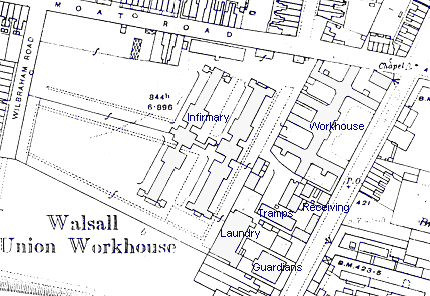
Walsall workhouse site, 1913
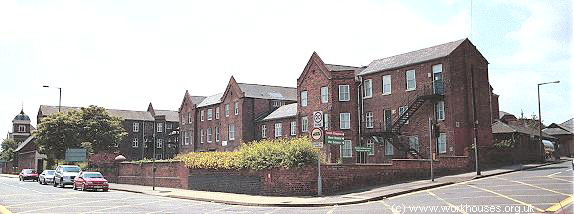
Walsall from the north-east, 2000.
© Peter Higginbotham.
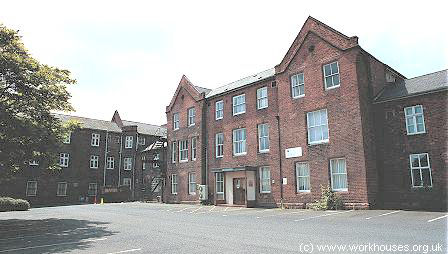
Walsall main entrance from the north-east, 2000.
© Peter Higginbotham.
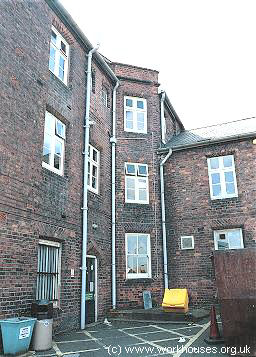
Walsall southern hub from the north-east, 2000.
© Peter Higginbotham.
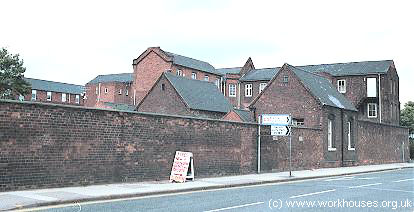
Walsall receiving wards from the south, 2000.
© Peter Higginbotham.
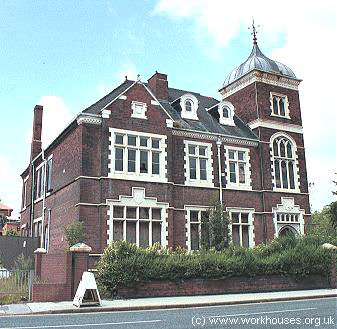
Walsall Guardians' building, 2000.
© Peter Higginbotham.
In 1929, the workhouse was renamed "Beacon Lodge" and the workhouse infirmary became "The Manor Hospital". In 1996 a large new hospital complex opened at the south-west of the workhouse site. Many of the original buildings still survive and are mostly now occupied by administrative and ancillary services.
In 1869, Walsall formed a partnership with the neighbouring WestBromwich Union to set up the Walsall and West Bromwich School District. The School District operated a district school at Wigmore.
In 1911, Walsall again joined West Bromwich to form the Walsall and West Bromwich Joint Committee for providing specialised care for certain categories of paupers away from the main workhouse. The Committee purchased Great Barr Hall at the north-west of West Bromwich and in 1918 opened a "colony for mental defectives".
Staff
Inmates
Records
Note: many repositories impose a closure period of up to 100 years for records identifying individuals. Before travelling a long distance, always check that the records you want to consult will be available.
- Walsall Local History Centre, Lichfield Street Hub, Lichfield Street, Walsall WS1 1TR. Holdings include: Guardians' minute books (1836-9, 1928-30); Register of lunatics (1877-1928); etc.
Bibliography
- A History of Walsall Hospitals (1838-1998) by PB Carpenter (1998).
Links
Unless otherwise indicated, this page () is copyright Peter Higginbotham. Contents may not be reproduced without permission.


